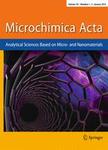版权所有:内蒙古大学图书馆 技术提供:维普资讯• 智图
内蒙古自治区呼和浩特市赛罕区大学西街235号 邮编: 010021

作者机构:Lanzhou Univ State Key Lab Appl Organ Chem Lanzhou 730000 Peoples R China Lanzhou Univ Dept Chem Lanzhou 730000 Peoples R China Lanzhou Univ Sch Basic Med Sci Lanzhou 730000 Peoples R China Lanzhou Univ Key Lab Digest Syst Tumors Lanzhou 730000 Peoples R China
出 版 物:《MICROCHIMICA ACTA》 (Microchim. Acta)
年 卷 期:2019年第186卷第1期
页 面:1-1页
核心收录:
学科分类:081704[工学-应用化学] 07[理学] 08[工学] 0817[工学-化学工程与技术] 070302[理学-分析化学] 0703[理学-化学]
基 金:Fundamental Research Fund for the Central Universities Natural Science Foundation of Gansu Province, China [17JR5RA209]
主 题:Encapsulation structure Solid-solution interfacial autoredox reaction Electrochemical sensor In vitro cell detection
摘 要:CeO2-encapsulated gold nanoparticles (AuNPs) were anchored to reduced graphene oxide (RGO/Au@CeO2) by an interfacial auto-redox reaction in a solution containing tetrachloroauric acid and Ce(III) on a solid support. The resulting material was placed on a glassy carbon electrode (GCE) and used as an electrochemical hydrazine sensor at trace levels. The electrocatalytic activity of the modified GCE towards hydrazine oxidation was significantly enhanced as compared to only RGO/CeO2, or CeO2-encapsulated AuNPs, or AuNPsloaded on CeO(2)modified with RGO. This enhancement is attributed to the excellent conductivity and large surface area of RGO, and the strong interaction between the reversible Ce4+/Ce3+ and Au+/Au-0 redox systems. The kinetics of the hydrazine oxidation was studied by electrochemical methods. The sensor, best operated at a peak voltage of 0.35V (vs. saturated calomel electrode), had a wide linear range (that extends from 10nM to 3mM), a low detection limit(3.0nM), good selectivity and good stability. It was successfully employed for the monitoring of hydrazine in spiked environmental water samples and to in-vitro tracking of hydrazine in cells with respect to its potential ***2-encapsulated gold nanoparticles anchored on reduced graphene oxide with the strong interaction between the reversible Ce4+/Ce3+ and Au+/Au-0 reductions can be used for sensitive detection of hydrazine with detection limit of 3nM and good selectivity in environmental and biological samples.